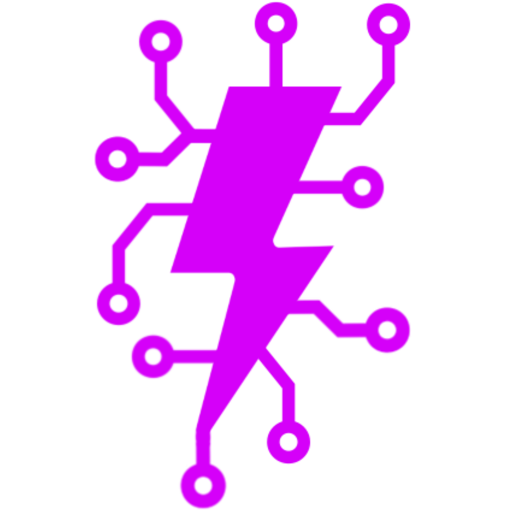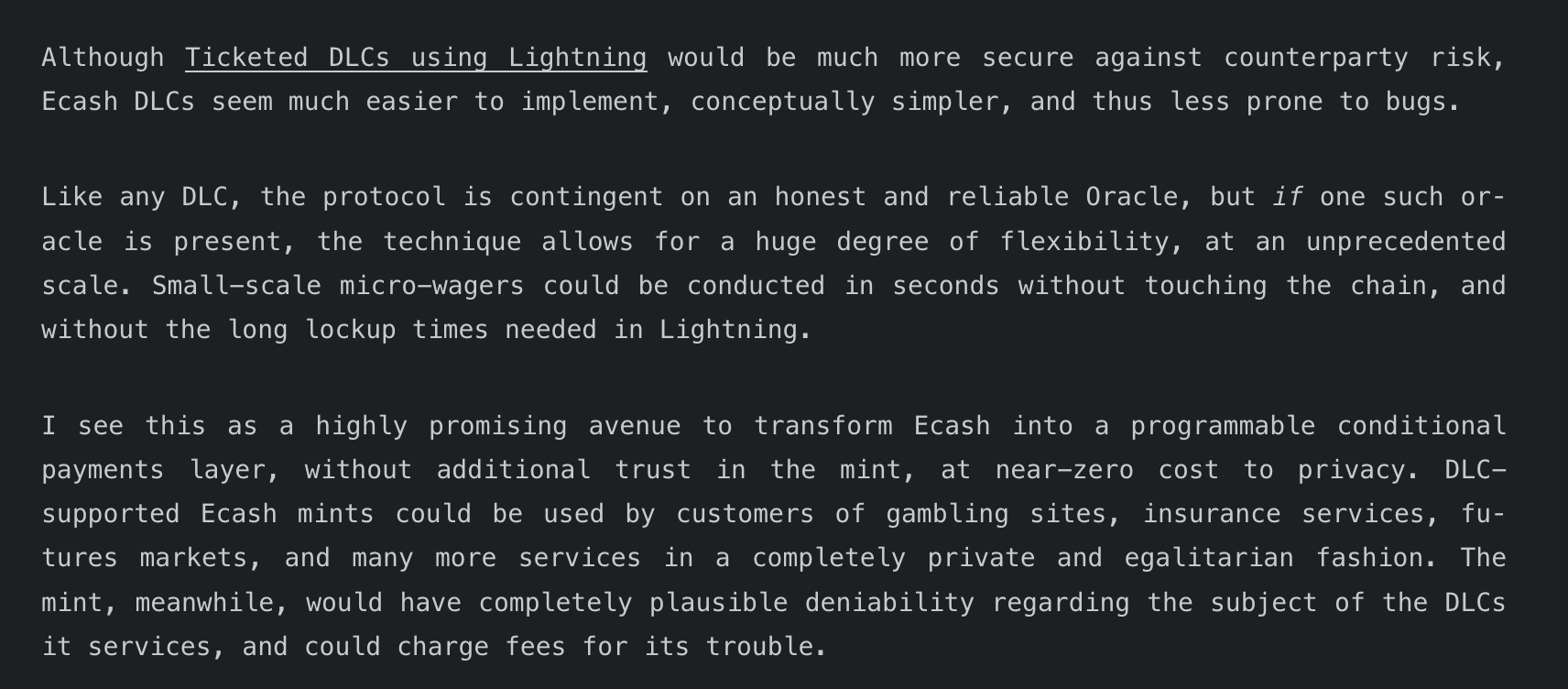

The haters are wrong about Chaumian Mints on bitcoin.
Ecash doesn't improve Bitcoin. It's the other way round. pic.twitter.com/owb97sSWKD
— dr. calle (@callebtc) May 21, 2024
There has been a lot of debate about whether or not the emergence of Chaumian Mints on top of bitcoin is overblown hype or a critical breakthrough that has the potential to unlock a lot of use cases for bitcoiners. If you've been following this newsletter for long enough you probably already know that I am very excited to see Chaumian Mints on top of bitcoin. As the chorus around eCash grows louder it seems like an opportune time to explain what these mints are, how they're currently being implemented, what they can enable and how they improve the original eCash design that was released in the early 1980s.
At a high level, Chaumian Mints on top of bitcoin allow individuals to lock bitcoin up in a "bitcoin bank" (mints) in exchange for fungible bearer tokens that are redeemable for bitcoin. The mints use blinded signatures to provide users with a high degree of privacy (if there is sufficient liquidity within the mint) while enabling them to transact cheaply and almost instantly. These mints are also interoperable with the Lightning Network, so mint users can pay lightning invoices directly or transfer sats from one mint to another using lightning as a connective tissue.
There are currently two dominant Chaumian Mint protocols available to the market today; the FediMint protocol and the Cashu protocol. Each makes different tradeoffs. FediMint enables a federated mint model, which leverages a multi-sig set up that dictates that m-of-n mint "guardians" need to sign off on transactions being made within the mint. This model distributes trust among multiple parties so an end users isn't wholly dependent on a single entity. The Cashu protocol enables individuals with the ability to spin up single-operator mints. This model allows any single individual or company to launch and operate a mint. The belief with this model is that it will lead to many smaller mints with specific use cases being launched at a quicker pace.
One of the most exciting things about what Chaumian Mints on bitcoin brings to the table is more robust financial applications. Since these mints are separate from the bitcoin and lightning protocols there is a new design space for application development that is simply not possible on bitcoin or lightning at the moment (and potentially never will be possible). Over the last week alone there have been two projects launched that highlight the power of these mints; Boardwalk Cash and a spec for a Discreet Log Contracts (DLCs) protocol within mints released by the pseudonymous developer Conduition.
Introducing https://t.co/sZE0EIEwjP - the first dollar-based @CashuBTC wallet built on top of #bitcoin and connected to #nostr.
— Prism (@makeprisms) May 14, 2024
We now have stablecash on bitcoin - completely interoperable with the lightning network. pic.twitter.com/Yg9D8GlrYC

These two projects highlight the potential extensibility of bitcoin's utility within mints. Boardwalk Cash is using stable channels on the lightning network to create stable value eCash tokens within a Cashu mint. Enabling users to access the utility of a Tether-like stablecoin experience without having to depend on US dollars or treasury bonds being held within the traditional financial system by trusted third parties. Instead they can create stable value eCash tokens fully backed by bitcoin held within specially managed lightning channels. This solution still comes with third party risk, but it is a wholly different model with different and, in my opinion, better tradeoffs.
Conduition's spec for DLCs within Chaumian Mint puts forth the most practical implementation of DLCs I've seen to date. DLCs are a concept that has been around since 2017, but haven't found very good product-market fit due to the clunky-ness that comes with implementing them on-chain or via the lightning network. By using DLCs within Chaumian Mint protocols the ability to develop great UX that brings speed, privacy and rapid iteration to the table is now possible.

To me, all of this is extremely exciting. However, there are many bitcoin users who think the emergence of Chaumian Mints reintroduces third-party custody risk that is seen as a non-starter. I'll be the first to admit that these mints certainly do introduce third-party risk to the bitcoiners who decide to interact with them. I just don't believe it's the non-starter that many are making it out to be. The more options the better.
At the very least, these mints offer an undeniably better solution to the third-party risk that already exists in the market. The open source permission-less nature of the mint protocols and the privacy guarantees they enable are objectively better compared to the status quo custodial solutions that dominate the market today. If I ever have to interact with a trusted third party I would much prefer that their service be built on top of a Chaumian Mint instead of the database infrastructure they are currently using today. eCash has been a good idea for decades. Unfortunately for David Chaum and the individuals that were helping him build out the eCash implementation of the 1980s, their timing was off.
When eCash mints were originally implemented way back then they were DOA because the people building the mints needed permission from the highly-regulated banking system to implement their technology. They had to plug into a highly gate-kept fiat system. As Calle mentions in the tweet at the top of this newsletter, eCash doesn't fix bitcoin, bitcoin fixes eCash as it was originally implemented.
The initial eCash implementation failed because it was built on top of a permissioned system. One could argue that the potential of eCash systems can finally be fully realized because they can now be built on top of the permission-less bitcoin and lightning networks. With the barrier to entry being completely destroyed, developers can begin to build truly cypherpunk applications that give users access to better privacy and the financial products that are fitting for a world built on electronic cash.
This will without a doubt come with tradeoffs for end users and those tradeoffs should be well articulated to and understood by end users. If you have a large stack of bitcoin I don't think it makes any sense to put a meaningful portion of your holdings into Chaumian Mints. Your life savings should be secured with keys that you fully control. With that being said, I think it would be asinine to say that no one should ever use these mints because of the tradeoffs that come with them. There are certainly instances where the tradeoffs make sense.
If you're looking for a daily spending wallet with great privacy and instant settlement guarantees, using eCash makes a lot of sense. If you want to put a small portion of your holdings into a mint that allows you to access stable value eCash tokens because you don't want to stomach short-term price volatility risks, that makes more sense to me than depending on a stablecoin which is dependent on the maintainer of that stablecoin having proper reserves or not getting taken out with a proverbial government cruise missile. There are many more examples where the tradeoffs of using a mint make sense.
It's very early days for Chaumian Mints on top of bitcoin, but they are showing a lot of promise. The beauty of bitcoin is that everything is opt-in. If you don't want to use eCash you do not have to. I think it is terribly misguided to write them off while they're still in the cradle.
Disclaimer (for all of the haters out there, of which there are many): Ten31 has provided no-strings-attached grants to both the FediMint and Cashu protocols and is invested in companies implementing Chaumian Mints. I am a Managing Partner at Ten31.
Final thought...
I can feel the Summer winds picking up from the East.



